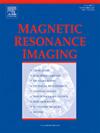基于单振荡波形的梯度时延估计。
IF 2.1
4区 医学
Q2 RADIOLOGY, NUCLEAR MEDICINE & MEDICAL IMAGING
引用次数: 0
摘要
目的:我们提出了一种利用单个振荡波形估计梯度延迟的有效方法。方法:提出基于单振荡波形的梯度延迟估计算法(SODA)。它通过测量连续时间点回波的相对位移来估计梯度延迟。通过在单一激励下获取所有梯度通道的三个自旋回波序列来实现加速度。通过仿真和仿真实验,将SODA与参考方法进行了比较。此外,我们在3 T扫描仪上使用高梯度振幅的集成序列监测梯度延迟随时间的变化。采用高分辨率成像技术对幻影和活体进行研究,比较有梯度延迟校正(GDC)和没有梯度延迟校正(GDC)的图像质量。结果:模拟结果表明,在噪声等级1到5时,SODA与参考方法在梯度延迟估计上没有显著差异。模拟结果证实了SODA的三次自旋回波序列与参考方法的六次脉冲重复延迟估计之间的强烈一致性。随着时间的推移,观察到梯度延迟几乎一致。对于高分辨率成像,使用GDC的重建比不使用GDC的重建对图像结构的描绘更清晰。结论:SODA可以在较短的校准扫描时间内提供准确的梯度延迟估计。三个自旋回波序列可以与任意主机序列无缝集成,测量梯度延迟,提供精确的螺旋轨迹。它可能是一种有价值的螺旋成像梯度延迟校正工具。本文章由计算机程序翻译,如有差异,请以英文原文为准。
A single oscillating waveform-based gradient delay estimation
Purpose
We present a time efficient method to estimate gradient delay using a single oscillating waveform.
Methods
Single oscillating waveform-based gradient delay estimation algorithm (SODA) was proposed. It estimated gradient delays by measuring the relative shifts of echoes acquired at consecutive time points. An acceleration was achieved by a three spin-echo sequence acquiring measurements for all gradient channels within a single excitation. Simulations and phantom experiments were carried out to compare SODA with a reference method. In addition, we monitored the change of the gradient delay over time using an integrated sequence with high gradient amplitude on a 3 T scanner. High-resolution imaging was performed for phantom and in vivo studies to compare images quality with and without gradient delay correction (GDC).
Results
Simulations showed no significant difference in gradient delay estimates when comparing SODA with the reference method for noise levels 1 to 5. The phantom results confirmed strong agreements on delay estimates between SODA with the three spin-echo sequence and the reference method with six pulse repetitions. The gradient delays were observed nearly consistent over time for the scanner. For high-resolution imaging, the reconstruction with GDC exhibit sharper and clearer depictions of images structures than reconstruction without GDC.
Conclusion: SODA can provide accurate gradient delay estimates with short calibration scan time. The three spin-echo sequence can be seamlessly integrated with any host sequence to measure the gradient delay and provide accurate spiral trajectory. It may be a valuable tool for gradient delay correction in spiral imaging.
求助全文
通过发布文献求助,成功后即可免费获取论文全文。
去求助
来源期刊

Magnetic resonance imaging
医学-核医学
CiteScore
4.70
自引率
4.00%
发文量
194
审稿时长
83 days
期刊介绍:
Magnetic Resonance Imaging (MRI) is the first international multidisciplinary journal encompassing physical, life, and clinical science investigations as they relate to the development and use of magnetic resonance imaging. MRI is dedicated to both basic research, technological innovation and applications, providing a single forum for communication among radiologists, physicists, chemists, biochemists, biologists, engineers, internists, pathologists, physiologists, computer scientists, and mathematicians.
 求助内容:
求助内容: 应助结果提醒方式:
应助结果提醒方式:


